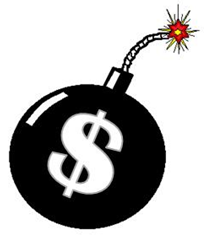In real terms, once adjusting for inflation, the U.S. economy in the first quarter contracted by 1 percent.
According to the Bureau of Economic Analysis, the drop was fueled by “negative contributions from private inventory investment, exports, nonresidential fixed investment, state and local government spending, and residential fixed investment that were partly offset by a positive contribution from personal consumption expenditures. Imports, which are a subtraction in the calculation of Gross Domestic Product (GDP), increased.”
So, fewer exports, more imports, less investment and, suddenly, the economy is shrinking again. Another bad quarter, and the nation will officially be back into a recession.
Which, five years after the last downturn, would not be surprising. The economy moves in cycles, averaging a recession once every 6 to 7 years since 1947.
In the next couple of years, we’re basically due for another one.
While that’s bad news enough, consider this. Since World War II, this has been by far the weakest recovery on record, in terms of growth, job creation, housing prices, you name it.
But why? What made the financial crisis of 2007 and 2008 so different from other recessions?
Well, a hint comes in the fact that there was a financial crisis — a high rate of defaults by individuals, corporations, financial institutions, and everyone else that led to a big credit contraction.
Predating the carnage was an unbridled expansion of debt. In 2001, the amount of debt outstanding at public and private was 276 percent of GDP. It grew to 364 percent by 2008.
Throughout the postwar period, strong credit growth was associated with periods of robust growth, but only to a point.
A 2011 paper by Stephen G. Cecchetti, M. S. Mohanty and Fabrizio Zampolli for the Bank for International Settlements finds that while credit during the boom cycle can certainly boost growth, beyond a certain level, debt becomes excessive and is a net drag on growth.
Writes Cecchetti and company, “Finance is one of the building blocks of modern society, spurring economies to grow. Without finance and without debt, countries are poor and stay poor. When they can borrow and save, individuals can consume even without current income. With debt, businesses can invest when their sales would otherwise not allow it. And, when they are able to borrow, fiscal authorities can play their role in stabilising the macroeconomy.”
So, borrowing helps purchases continue when otherwise income is unavailable. This moves consumption from the future into the present.
But, do it too much, and, according to the paper, “history teaches us that borrowing can create vulnerabilities. When debt ratios rise beyond a certain level, financial crises become both more likely and more severe.”
Which was the brick wall the economy ran into in 2007. As for the weak recovery — growth has averaged only 2.25 percent from 2010 through 2013, compared with a post-war average of 3.36 percent through 2007 — one need look no further than the excessive debt that still sits on the books.
At a 2013 level of $58.9 trillion, all debts public and private still sits at a distressing 350.7 percent of GDP.
Just look at the first quarter. According to the Federal Reserve, debt held by financial institutions actually contracted by $103 billion to its current level of $13.8 trillion, almost a 1 percent drop. More than five years after the financial crisis, and banks are still cleaning up their balance sheets.
And this may be as good as it gets, as banks may have a lot more to clean up in the future. With the U.S. contracting, Europe frozen in time, and the credit bubble unraveling in Asia and the Pacific regions, the worst may be yet to come.
But, even then, since banks can just dump bad debts onto the Federal Reserve via quantitative easing bailouts, we might not expect the debt to GDP levels to shrink that much at all. The defaults are not really being allowed to happen, bad debts are simply being transferred. That’s what is choking up the system, and will make this process last much, much longer.
As for now, does that mean the recovery is over? Perhaps not yet. But, if history is any guide, it will be in the not so distant future.
Robert Romano is the senior editor of Americans for Limited Government.







